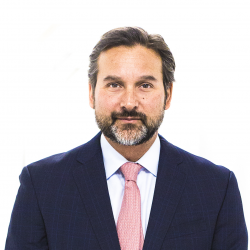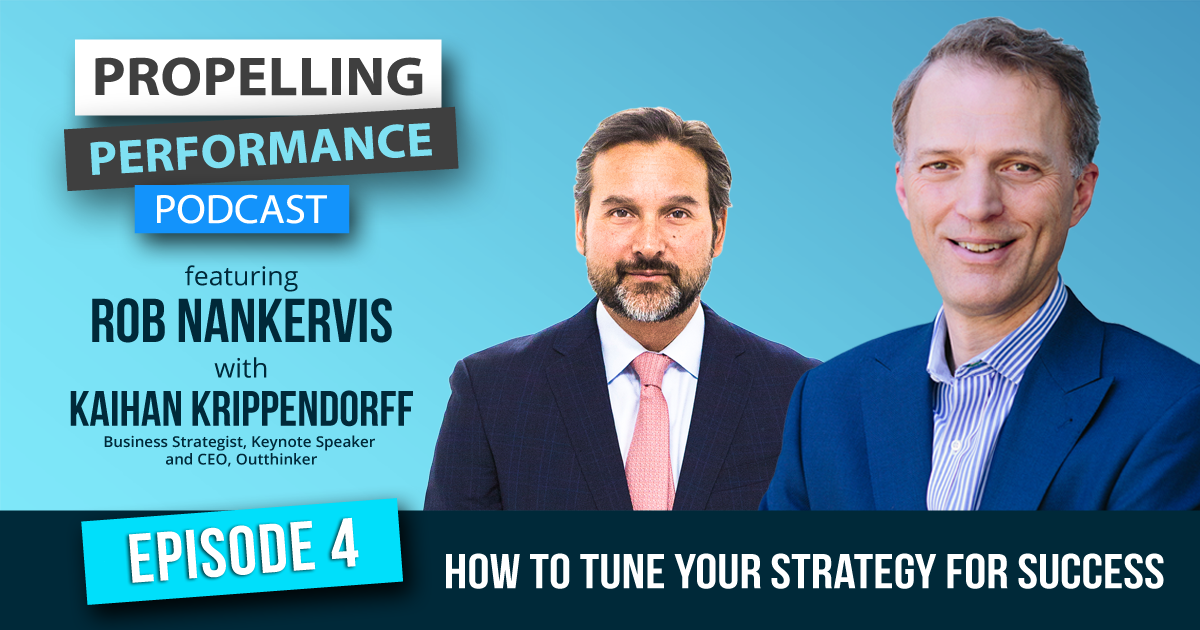Propelling Performance Podcast
Episode – Four
featuring Rob Nankervis
with Kaihan Krippendorff
In Episode Four, Rob dives into strategy with one of the top eight innovation thought leaders in the world, Kaihan Krippendorff.
Founder of growth strategy and innovation consulting firm Outthinker, member of the prestigious Thinkers50 Radar group and finalist for the Thinkers50 Distinguished Achievement Award in Innovation in 2019, Kaihan Krippendorff lives and breathes strategy every day.
“Strategy is not like science or medicine where we have agreement on what terms are and should be. I believe we should look at strategy as a living breathing thing – an ongoing exploration, where we introduce new terms and language into a body of knowledge.” – Kaihan Krippendorff
Listen to discover:
- Why Kaihan sees strategy as intangible – a ‘living, breathing thing’
- The five common mistakes people make in tuning their strategy….
- making incremental goals based on the past
- focusing too narrowly on one element of your business model
- limiting ourselves to the consideration of only a few strategies
- deciding to do what looks most logical and likely because it’s been done before
- failing to view strategy as a conversation that engages stakeholders.
- Why ‘vision without action is a daydream, but action without vision is a nightmare’
- Aligning strategy with a belief system
- How Outthinker views each strategic concept through 36 different lenses, including the ‘deer in the headlights moment’ and ‘coordinating the uncoordinated’
- Why a smaller pool of ideas is less likely to result in an optimal strategy
- The importance of ‘killing off a strategy’
- Kaihan’s five levels of strategy from the Way of innovation –
- Metal (Admit you are stuck)
- Water (Conceive new winning options)
- Wood (Assemble your resources)
- Fire (Break out your innovation)
- Earth (Make it sustainable)
- The three Box Model; doing stuff that creates the new future, doing stuff that strengthens and maintains the current future (your core) and forgetting and stopping stuff
- How a crazy idea can become the differentiator – “it’s the difficult things that differentiate you – those high impact difficult ideas that we call crazy ideas.”
- How to use an ‘ideas matrix’
- The story of how the IKEA flat pack box turned IKEA into the largest furniture retailer in the world.
Take Action
- How can you focus attention, activities and assets in such a way that you achieve what you want for your organisation?
- Your breakthrough idea is not going to come from you as the CEO or the founder. It is going to come from your employees. Your job is creating the context for people to act entrepreneurially inside your company. How can you enable your people to think like strategically?
- Will you add a ‘crazy ideas’ quadrant to your ideas matrix?

Kaihan Krippendorff
Business Strategist, Keynote Speaker and CEO, Outthinker
Rob Nankervis – Podcast guests – Season 1
Kaihan Krippendorff has made a commitment to helping organizations and individuals thrive in today’s era of fast-paced disruptive technological change.
He began his career with McKinsey & Company before founding the growth strategy and innovation consulting firm Outthinker, whos growth strategies and innovations have generated over $2.5B in revenue for many of the world’s most recognizable companies including BNY Mellon, Citibank, L’Oréal, Microsoft, and Viacom. He is a best-selling author of five books, most recently the Edison Award nominated, Driving Innovation From Within: A Guide for Internal Entrepreneurs.
Kaihan is a member of the prestigious Thinkers50 radar group – A global selection of the top 30 management thinkers in the world to look out for. Thinkers50 also recognized Kaihan as one of the 8 most influential innovation thought leaders in the world considering him for a Distinguished Achievement Award in Innovation – given to the person in the world that has contributed the most to the world’s understanding of innovation in the past two years.
Amidst his dizzying schedule of keynote speeches, consulting projects, ongoing research and writing, Kaihan still finds time to teach at business schools throughout the US and internationally. Regularly featured in major business media outlets Kaihan is an advisory board member of multiple national and international companies.

